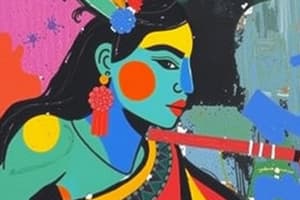Podcast
Questions and Answers
What is the name of the early Filipino script?
What is the name of the early Filipino script?
Baybayin
The early Filipinos engaged in trade for profit in a subsistence economy.
The early Filipinos engaged in trade for profit in a subsistence economy.
False (B)
What is animism?
What is animism?
- The belief that various objects, places, and creatures possess distinctive spiritual qualities (correct)
- The practice of scientific observation
- A form of written communication
- The belief in one deity
Which metal tools did early Filipinos learn to make?
Which metal tools did early Filipinos learn to make?
What type of crops did early Filipinos grow?
What type of crops did early Filipinos grow?
When did the Iron Age last in the Philippines?
When did the Iron Age last in the Philippines?
Barangays are self-sufficient, autonomous communities present all over the archipelago long before the ______ came.
Barangays are self-sufficient, autonomous communities present all over the archipelago long before the ______ came.
What type of boat was the refined warship called that the early Filipinos built?
What type of boat was the refined warship called that the early Filipinos built?
The early Filipinos did not domesticate animals.
The early Filipinos did not domesticate animals.
Which areas did early Filipinos settle in?
Which areas did early Filipinos settle in?
Study Notes
Pre-Colonial Philippines: Culture and Traditions
- Filipinos practiced animism, believing objects, places, and creatures possessed spiritual qualities called diwata.
- This belief system shaped their understanding of natural phenomena, often attributing events like rain to spirits rather than natural processes.
Pre-Colonial Philippines: Writing System
- Filipinos had their own writing system, Baybayin, primarily used for messages and letters.
- The lack of a written literary tradition hindered knowledge accumulation and dissemination, impacting the development of science and technology.
Pre-Colonial Philippines: Social Organization
- Barangays, autonomous communities, were scattered throughout the archipelago.
- These communities primarily focused on subsistence economies, producing goods for their own needs, with exceptions for those involved in trade.
Pre-Colonial Philippines: Craftsmanship
- Filipinos' craftsmanship evolved over time from simple stone tools to sophisticated metal implements.
- They mastered techniques like sawing, drilling, and polishing stones, producing adzes, ornaments, and pottery.
- The Iron Age (2nd/3rd century B.C. to 10th century A.D.) saw them engage in iron extraction, smelting, and refining.
Pre-Colonial Philippines: Transportation
- Filipinos developed boat building for coastal trade by the 10th century A.D.
- The caracoa, a sophisticated warship, facilitated inter-island trade and raids.
- Regular trade relations were established with Champa (Vietnam) and China, evidenced by Chinese records.
Pre-Colonial Philippines: Agriculture
- Filipinos cultivated crops like rice, cotton, and vegetables.
- They domesticated swine, goats, and fowls.
- Rice cultivation included both lowland diked fields and terraced fields in the Cordillera region.
Pre-Colonial Philippines: Settlement
- Filipinos settled in coastal areas and mountainous regions.
- Coastal settlements, exposed to foreign trade and cultural exchange, experienced greater development.
Studying That Suits You
Use AI to generate personalized quizzes and flashcards to suit your learning preferences.
Related Documents
Description
Explore the rich cultural heritage of the pre-colonial Philippines, including belief systems, writing practices, social organization, and craftsmanship. This quiz delves into the unique aspects of Filipino life before colonial influences, highlighting their traditions and societal structures.




